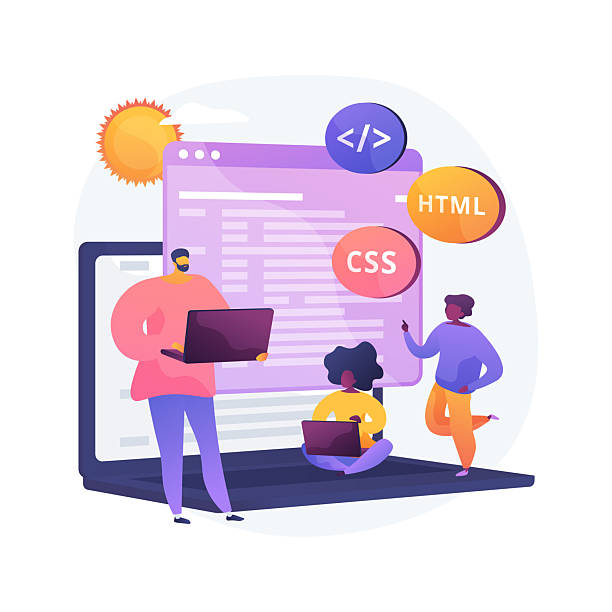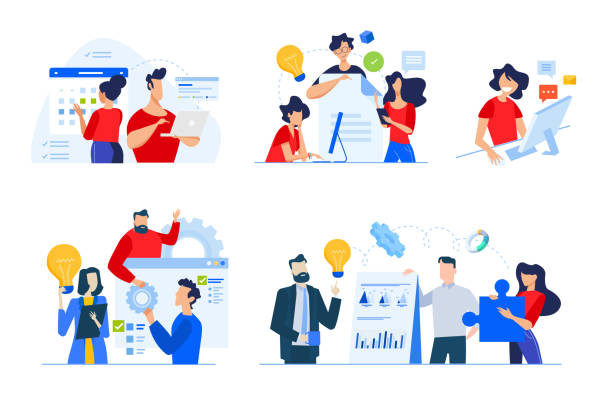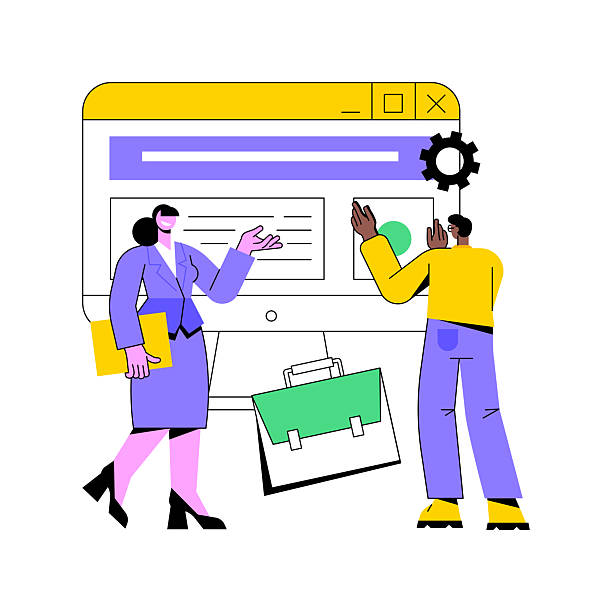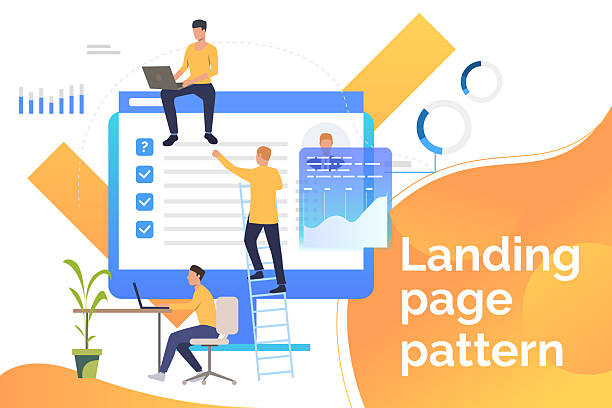Introduction and the Importance of Fast Website Design in Today’s World

In the current digital age, website speed is not just a competitive advantage, but an absolute necessity.
Today’s users are highly sensitive to page loading speed, and even millisecond delays can lead to lost visitors and business opportunities.
#SiteSpeed, #UserExperience, and #SEO are the three main pillars upon which fast website design is built.
A slow website can significantly increase the bounce rate, meaning visitors leave the page before seeing your content or getting to know your business.
Search engines like Google also consider loading speed as an important factor in page ranking.
This means if your website is slow, it might be less visible in search results.
Therefore, the importance of fast website design is more evident than ever in today’s world.
This directly affects user satisfaction, conversion rates, brand credibility, and ultimately, your business’s online success.
Studies show that most users expect a website to load in less than three seconds.
The longer this time, the higher the likelihood of site abandonment.
This urgent need for speed has compelled developers and website owners to seek new solutions for performance optimization.
Speed is not just about reducing waiting time; it creates a better user experience, strengthens SEO, and ultimately increases profitability.
Therefore, investing in speed optimization is investing in the future of your business.
Did you know that 94% of a first impression of a company is related to its website design?
Rasaweb, by offering professional corporate website design services, helps you create the best first impression.
✅ Create a professional and trustworthy image for your brand
✅ Easier attraction of potential customers and improvement of online positioning
⚡ Get free corporate website design consultation
Key Factors Affecting Website Speed

A website’s speed is a function of multiple complex factors that collectively influence the final loading time.
Understanding these factors is crucial for any effort towards fast website design.
#Hosting, #ImageOptimization, and #OptimizedCode are just a part of this set.
Choosing the type of hosting is the first and one of the most important steps; a server weak or overly crowded shared hosting can be a bottleneck for your website’s performance.
After that, the size and optimization of visual content, especially images, play a very important role.
Large images without proper compression can significantly increase loading time.
Code quality is also a decisive factor.
Disorganized code, bulky scripts, and unoptimized CSS/JavaScript can cause slow page rendering.
Using numerous plugins and add-ons, especially those not properly coded, can impose an extra load on the server and the user’s browser.
The lack of using a Content Delivery Network (CDN) is another speed-reducing factor, as CDN delivers content from the server closest to the user, reducing data transfer time.
Finally, database optimization, content caching, and using Gzip compression are also technical factors that directly affect loading speed.
A comprehensive approach to identifying and addressing these bottlenecks is the foundation for achieving an incredibly fast website. Each of these factors must be carefully reviewed and optimized to achieve maximum speed.
Techniques for Optimizing Images and Multimedia Files for Fast Website Design

Images and multimedia files often constitute a significant portion of a web page’s size.
Proper optimization of these is one of the most effective steps towards achieving fast website design.
#Compression, #WebImages, and #LazyLoading are key techniques in this area.
The first step is to use appropriate image formats.
Formats like WebP are ideal options due to providing high quality with smaller file sizes, while JPG is better for photos and PNG for images with background transparency.
Compressing images without a noticeable loss of quality is the second step.
Online tools and CMS plugins can perform this automatically.
The “Lazy Loading” technique also means that images are only loaded when the user scrolls to the relevant part of the page, not at the beginning of page loading.
This significantly reduces the initial page loading time. Also, ensuring the correct dimensions of images are used and preventing the loading of images larger than actually needed is very important.
For example, if an image is displayed on the page with a width of 500 pixels, a version with a width of 2000 pixels should not be loaded.
Using a CDN for hosting images and videos also significantly helps improve user access speed.
By applying these techniques, the overall page size can be drastically reduced, achieving exceptionally fast performance.
| Image Format | Recommended Use Cases | Benefits for Site Speed |
|---|---|---|
| WebP | Graphic and photographic images, logos | Smaller size with high quality, transparency support |
| JPEG (JPG) | Photos and complex images with high detail | Good compression for photos, widespread support |
| PNG | Logos, icons, images with transparency | Full transparency support, no quality loss |
| SVG | Icons, logos, vector graphics | Very small size, scalability without quality loss |
The Role of Choosing Suitable Hosting in Website Loading Speed

Choosing suitable hosting is one of the most important decisions that can have a significant impact on your website’s loading speed, ultimately contributing to fast website design.
#HostingTypes, #ContentDeliveryNetwork, and #Server are concepts that are of great importance in this regard.
A quality hosting provider, with strong and optimized infrastructure, can make a big difference in your website’s performance.
Shared hosting, although cheaper, shares server resources with other websites, which can lead to slowdowns during high traffic.
In contrast, Virtual Private Servers (VPS) or Dedicated Servers allocate more resources to you and ensure better performance.
The server’s location also matters greatly; the closer the server is to your target audience, the lower the latency and the faster the loading speed. Using a Content Delivery Network (CDN) is another highly effective solution.
CDN stores your website’s static content (such as images, CSS, and JavaScript) at multiple geographic locations worldwide and delivers it from the server closest to the user, thereby significantly improving loading speed for users in different parts of the world.
Before choosing a hosting provider, do sufficient research, check user reviews, and ensure high technical support and uptime.
How much does losing business leads due to an unprofessional website cost you? Solve this problem forever with Rasaweb’s professional corporate website design services!
✅ Increase credibility and trust of potential customers
✅ Easier attraction of new business leads
⚡ Get a free consultation now!
Optimized Coding and Design Standards for High Speed

The foundation of any fast website is clean and optimized coding.
Adhering to coding standards and employing specific techniques plays a vital role in achieving fast website design.
#MinimalCode, #CleanCoding, and #AsynchronousLoading are principles that should be considered.
The first step is minification of CSS, JavaScript, and HTML files.
This process involves removing unnecessary characters such as spaces, comments, and new lines from the code, which reduces file sizes and speeds up loading.
Using asynchronous or deferring the loading of scripts and stylesheets until the main page content is loaded can significantly improve the initial page rendering time.
Avoid bloated code and using unnecessary plugins that can reduce performance. Additionally, optimizing CSS and JavaScript so that only the necessary codes for each page are loaded is very important.
For example, using Critical CSS to quickly load essential page styles at the beginning of the HTML improves the user experience.
Using lightweight and efficient frameworks and avoiding excessive dependencies on external libraries are also key points.
Finally, validating HTML and CSS codes against W3C standards also helps improve quality and speed.
Tools and Plugins for Increasing Site Speed

To achieve the goals of fast website design, using specialized tools and plugins can be very beneficial.
These tools help identify speed bottlenecks and provide solutions for optimization.
#Caching, #PerformanceTools, and #Lighthouse are among the very practical items in this field.
Caching plugins like WP Super Cache or LiteSpeed Cache for WordPress, by storing a version of your website’s pages in the server’s temporary memory, make the page load faster on subsequent visits.
These plugins automatically serve static files and eliminate the need for re-processing by the server.
Performance analysis tools like Google Lighthouse and GTmetrix, provide detailed reports on site speed status and identify weaknesses.
These reports include suggestions for image optimization, code minification, fixing JavaScript and CSS errors, and improving server response time.
Regular use of these tools is essential for monitoring and continuously improving website speed. Additionally, there are plugins for image compression (like Imagify or ShortPixel), database optimization, and lazy loading, each contributing to increased speed in its own way.
Proper selection and optimal management of these tools can pave the way for achieving an incredibly fast website.
Security and Database Optimization in Fast Website Design

The database is the heart of every dynamic website, and its optimization plays a significant role in fast website design.
An unhealthy or inefficient database can severely reduce page loading speed and even harm website security.
#DatabaseOptimization, #WebSecurity, and #QueryWriting are three key areas in this regard.
Ensuring regular cleanup of the database from unnecessary data such as spam comments, old post revisions, and transient data created by plugins is essential.
Inefficient SQL queries can put a heavy load on the server and increase its response time.
Therefore, optimizing the database structure and writing efficient queries for data retrieval and storage is very important. Using indexes for frequently used fields in database tables can significantly increase information retrieval speed.
Also, for security, regular updates of the database and Content Management System, regular backups, and using Web Application Firewalls (WAF) to prevent SQL injection attacks are essential.
An optimized and secure database not only contributes to website speed but also ensures its stability and reliability.
Ignoring database optimization means ignoring one of the greatest potentials for website speed improvement.
| Database Optimization Technique | Description | Impact on Site Speed |
|---|---|---|
| Regular Cleanup | Removing redundant data, spam comments, old revisions | Reducing database size, improving query speed |
| Query Optimization | Rewriting inefficient queries, using appropriate JOINs | Reducing database response time, increasing loading speed |
| Proper Indexing | Creating indexes on frequently used fields | Significantly increasing data search and retrieval speed |
| Using Database Caching | Storing results of frequently used queries in cache memory | Reducing the number of database requests and higher speed |
The Impact of Responsive Design and Mobile-First on Site Performance

In today’s world, where a significant portion of web traffic comes from mobile devices, responsive design and a mobile-first approach are crucial not only for user experience but also for achieving fast website design.
#MobileFirst, #ResponsiveDesign, and #AMP are concepts that are important in this regard.
Responsive design means designing a website that automatically adapts its layout and elements to the screen size of the user’s device (desktop, tablet, mobile).
This approach ensures that users have an optimal user experience regardless of the device they use.
Google has also emphasized mobile-first indexing for years; this means Google primarily considers the mobile version of your website for ranking and indexing.
Therefore, a mobile-friendly and fast website for mobile directly impacts your SEO and visibility.
Using Accelerated Mobile Pages (AMP) can also extraordinarily increase page loading speed on mobile, although its pros and cons should be considered.
A website that is not optimized for mobile, even if it is fast on desktop, will quickly be eliminated from competition in today’s world. Responsive design not only improves speed but also reduces maintenance costs, as it eliminates the need to manage separate desktop and mobile versions.
Do your e-commerce site visitors leave before making a purchase? Don’t worry anymore! With Rasaweb’s professional e-commerce website design services, solve the problem of not converting visitors into customers forever!
✅ Significant increase in conversion rates and sales
✅ Unique and engaging user experience
⚡ Contact us now for a free consultation!
The Future of Fast Website Design and New Trends

The topic of fast website design is constantly evolving, and new trends are emerging that are shaping the future of web speed.
#WebAI, #PWA, and #NewTrends indicate the path forward for this industry.
One of the most significant recent developments is Google’s focus on Core Web Vitals, which defines specific metrics for measuring user experience, including loading speed, interactivity, and visual stability of pages.
These metrics increasingly impact SEO rankings and compel developers to deeper optimization.
Progressive Web Apps (PWAs) technologies are also gaining popularity.
PWAs enable websites to behave like native applications, with features such as offline access and push notifications, significantly improving speed and user experience.
Artificial intelligence (AI) and machine learning have also found an increasing role in automatic website optimization, from intelligent image compression to content preloading based on user behavior.
Serverless Architectures and the broader use of Edge Computing are also changing how content is delivered, leading to reduced latency and increased speed.
These trends indicate that the future of websites is moving towards unprecedented speed, high interactivity, and fully personalized user experiences.
Conclusion and Practical Steps for Fast Website Design

Achieving fast website design is a continuous process that requires attention to technical details and continuous monitoring.
#PracticalSteps, #PerformanceMonitoring, and #ContinuousImprovement are principles that must be observed on this path.
First, always start by choosing quality hosting suitable for your website’s needs.
Then, focus on optimizing images and multimedia files, utilizing modern formats and techniques like lazy loading.
Clean coding and compression of CSS and JavaScript files are the next steps.
Using caching systems and CDN is also essential to speed up content delivery to users worldwide.
Regular database optimization and ensuring its security are other critical aspects that are often overlooked. Finally, always monitor your website’s performance with tools like Google Lighthouse and apply necessary improvements based on the reports.
Remember that website speed is not a fixed factor, and with content additions or traffic changes, re-optimization may be needed.
By following these practical steps and maintaining a continuous improvement approach, you can ensure that your website remains fast, efficient, and competitive, providing the best experience for your users.
Frequently Asked Questions
| Question | Answer |
|---|---|
| What is fast website design? | A process for building a website that loads quickly and provides a smooth and optimized user experience. |
| Why is site speed important? | Increased user satisfaction, improved search engine ranking (SEO), reduced bounce rate, and increased conversion rate. |
| What factors affect site speed? | Page size, number of HTTP requests, image optimization, JavaScript and CSS codes, server speed, and cache usage. |
| How can site speed be measured? | Using tools like Google PageSpeed Insights, GTmetrix, Pingdom Tools. |
| How can site speed be increased? | Optimizing images, compressing files (CSS, JS, HTML), browser caching, reducing redirects, choosing suitable hosting. |
| Does fast website design mean low quality? | No, fast design means focusing on optimizing speed and efficiency, not reducing the quality of design or content. |
| What is the role of hosting in site speed? | The speed and quality of the hosting server directly impact the site’s response time and consequently, loading speed. |
| How can images be optimized for speed? | Using appropriate formats (e.g., WebP), compressing images without significant quality loss, specifying exact dimensions for images. |
| Can complex websites also be fast? | Yes, by using appropriate architecture, optimizing codes, and managing resources, even complex sites can have high speed. |
| Is fast website design the same as Agile development? | No, fast website design focuses on the final result (a fast site), while Agile development is a methodology for project management and software development. |
And other advertising agency services from Rasaweb in the field of advertising
The role of high-quality images in the success of pet supply ads on industrial websites
Examining the impact of pricing on customer acquisition through industrial ads
How to use attractive descriptions in pet supply ads
Is the use of keywords in ads effective? A case study of pet supplies
Strategies to increase visibility and clicks for pet supply ads on industrial websites
And more than hundreds of other services in the field of internet advertising, advertising consultation, and organizational solutions
Internet Advertising | Advertising Strategy | Advertorial
🚀 With Rasaweb Afarin, a leading digital marketing agency, build your online business’s future today. We pave your path to success by offering creative and specialized solutions, including multilingual website design, SEO, and targeted social media management. Trust us to shine in the digital world.
📍 Tehran, Mirdamad Street, next to Bank Markazi, Kazeroun Jonoubi Alley, Ramin Alley No. 6


